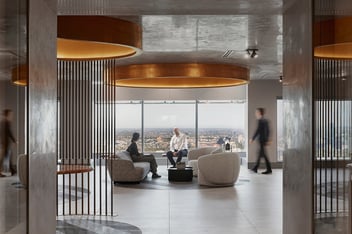As people begin returning and spending more time in the office, employers have to make sure that the physical workspace keeps everyone engaged and productive. They not only need to create a company culture that is safe and supportive, but one that also aligns with the company’s purpose and values.
In this blog post, we look at how you can design a workplace that effectively communicates your values to your team, clients and customers, and why this is important.
How your workplace design can communicate company values
Company values are more important than ever—they set the tone for how employees communicate with their clients and each other and more—but if they’re not communicated well, businesses won’t be able to realise the benefits they bring.
The office is not just a physical space to do work. It’s not just an area with walls, desks, rooms and windows. An office is a place where people can collaborate, socialise and share ideas, views and aspirations. And the actual design of your workplace can have a significant impact in creating a supportive, engaging and productive culture.
Workplace design creates an environment that supports your brand and tells your story. Each design element can communicate to employees, clients and customers the core values that represent who you are as a company.
Here are some steps to make your workplace design reflect company values.
1. Define your company values
The workplace design process doesn’t start with choosing the right colours, lighting or layout. It begins with defining and establishing your core values. This is an opportunity for your business to refocus on your mission as a company, determine your ‘why’, and review the values and principles that are essential for both management and staff.
This is a critical step in the process – and should not be skipped. It builds the foundation that guides the way forward. So, take the time to re-examine and define your company values before you start thinking about how to translate them into the physical workplace.
2. Design the workplace to reflect your values
When you have defined and established your core company values, it’s important to communicate them across the whole business. Conduct company-wide presentations and team workshops. Email your values to each employee, and have team managers lead the way in practising those values.
One important aspect in this step of the process is to have a look around the office and review the physical workspace. Does your office interior design reflect your company values? If not, you’ve missed an important opportunity to communicate your values internally and externally.
Let’s take a set of example values and talk about how we could create a workspace to align and promote them.
Company values: Empowerment, Real People, Innovation and Customer-Centric.
- Create a front of house area that is prominent and purposely designed to host clients and external visitors to ensure being customer-centric is clear to all. Continue on with this theme by choosing a higher level of finish and furnishing and mood lighting, artwork to emphasise the importance of visitors. More specifically, the choice and style of furnishings also need to portray the appropriate tone and language to anyone who visits your office, e.g. timber veneers and the use of a reasonable amount of glazing reinforces trust and transparency, but also may delineate front of house from back of house, assuring your clients that their IP protected when you work for them.
- Using seamless technology connections focuses on the values of customer-centric, innovation and making the design for real people. How does this work in practice? By designing a workplace where employees can drop into unbookable spaces to accommodate a client that has arrived unannounced and needs a quick meeting. The employee can book the space at the door of the room for 30 minutes with no fuss and hassle, making the experience great for the client. Need to connect to the AV and dial in a virtual team member? No problem. It’s all done at the touch of a button and intended to accommodate and facilitate the client’s needs empowering everyone to collaborate efficiently.
- Include ‘experience centres’ to address innovation and customer-centric needs by facilitating a curated experience for people. How? Design for creative sessions, change the lighting, allow writing and sticking onto all walls, use modular furniture and a variety of settings within a room to create a sense of innovation when combined with high tech solutions in lighting and VC/AV equipment.
- Include right-sized, placed and styled collaboration, entertainment and social spaces to empower employees to host client-centric meetings and workshops that treat everyone like real people.
- Design social spaces that accommodate employee activities – keeping it real for them in how they connect their support services, reinforcing that real people connect with their real needs being met. It might be as simple as a functional kitchen layout with enough recycling bins, sufficient microwaves placed correctly and free access to the filtered water tap without having to impede the packing of the dishwasher.
- Provide choice in work settings i.e. flexibility about when you are in the office to choose the most productive work setting in order to empower and enable customer-centric responses by cutting down response time.
- Include sufficient focus and quiet spaces – this again means real people are getting their real needs met and enables high performance.
3. Consider employee habits and work preferences
Building a values-based workplace and culture would not be successful without the input and support of your employees. Engage them in the workplace design process. Ask them what works, what doesn’t, if the workspace communicates the right mood or perception, and how to best implement any changes. It’s also important to consider work habits and how teams collaborate and work together.
Designing the best physical space where employees feel comfortable and energised, can do wonders in enhancing work performance and productivity in the long run.
4. Partner with workplace design experts
Let’s face it – creating an environment that reflects your values would require a lot of time planning, coordinating and building. Consider working with workplace strategy and design experts to help you do the job properly and efficiently. Companies like Axiom can help you strategise, design and build a physical workspace that reflects your culture, communicates your core values, and improves staff well-being and performance.
Why company values are important
Now that we’ve seen how to make your workplace design reflect company values, it’s essential to understand why your core values matter in the first place.
Your company values matter especially in these times of uncertainty and change. They build the foundation of your company culture and serve as a guiding force for both management and employees. Here are a few reasons why company values are important:
Values keep your business unique
Core values not only create the culture within the organisation but also stay consistent with the company’s overall identity. They help communicate the brand story and build on the ‘why’ of the business – why you do what you do, why you’re different from the competition, and why the company was established in the first place.
They unite staff with a common purpose
People want to be inspired. They want to know that their work contributes to something bigger than themselves. Company values can help create that bond between individuals and teams to work together to achieve common goals and fulfil a shared mission or purpose.
They drive team performance
When employees are working together for a common purpose, they feel more engaged with their work; more energised and motivated. Team productivity and performance, therefore, significantly improve.
Want to learn more about creating the best workplace that reflects your company values? Read our Future of Work guide and see what’s in store for employees, employers and workplaces in 2021 and beyond.






